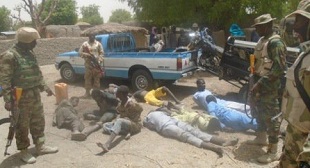Kano, Nigeria | AFP |
One of 219 schoolgirls held hostage by Boko Haram Islamists for more than two years has been found, the military and activists said Wednesday, the first rescue that has raised hopes for those still being held.
Amina Ali was discovered on Tuesday in the Sambisa Forest area of Borno state by civilian vigilantes and soldiers on patrol and was brought back to her home town of Mbalala, near Chibok.
“When her mother approached the car the girl stepped out and her mother exclaimed, ‘Amina! Is that you?’,” Ayuba Alamson Chibok, a local community leader, told AFP.
“They ran towards each other and hugged. The mother burst into tears.”

The rescue is a rare positive in the ordeal of the schoolgirls, whose abduction sparked global outrage and brought world attention to a brutal conflict in northern Nigeria that has killed at least 20,000 since 2009.
Nigeria’s army said Ali was found with “a suspected Boko Haram terrorist, Mohammed Hayatu, who claimed to be her husband”, as well as a four-month-old girl named Safiya.
A photograph provided by the military showed a young woman sitting in a plastic chair, wearing flip-flops, a patterned hijab and pink wrapper common in the region.
She was cradling the infant in one arm and a plate of food in the other.
218 still missing
Yakubu Nkeki, head of the Abducted Chibok Girls Parents’ group, said the teenager, who was 17 when she was kidnapped, was brought to his house where she was reunited with her mother.
She was then handed over to the military and taken to the nearby town of Damboa, he told AFP.
Army spokesman Sani Usman said Ali, Hayatu and Safiya were transferred to the state capital, Maiduguri for “further medical attention and screening”.
The BringBackOurGirls campaign group said Ali “provided useful information that her other classmates are still held under heavy terrorist captivity in the Sambisa Forest area”.
But she was quoted as saying by Chibok community leader Tsambido Hoseana Abana that “six were already dead”.
The Sambisa Forest has long been known to contain Boko Haram camps. Other abducted women rescued from the former game reserve over the last year have reported seeing some of the Chibok girls.
Members of the BringBackOurgirls movement in Nigeria’s capital, Abuja, were in ecstatic mood at the news but the group’s leader, Oby Ezekwesili, said: “We still have 218 of them.
“We are going to use Amina as a symbol for calling the 218 until they come back. They have no reason to stay one extra day in (the) terrorist enclave.”
The group has mounted daily vigils in the capital since the abduction, calling for the girls and other hostages to be released.
A senior UN official Wednesday welcomed the “wonderful piece of news” of Amina’s return.
“There is a sense of solidarity and a real sense of hope that this is a step toward the future,” UN emergency relief coordinator Stephen O’Brien told reporters by telephone from the nearby city Maiduguri. He also stressed the need to continue efforts to find the rest of the Chibok girls and thousands more people held by the jihadist group.
First step
Boko Haram has used kidnapping as a weapon of war, seizing thousands of women and young girls, forcing them to become sex slaves and even suicide bombers.
Men and young boys have also been forcibly conscripted to the Islamists’ ranks.
UNICEF spokeswoman in West and Central Africa Helene Sandbu Ryeng said for Ali and others rescued, “being freed from Boko Haram and returning home is only the first step”.
“Children in this situation typically require medical assistance and psycho-social support to help them cope with what they have been through while they were in captivity,” she said.
“Many of them need help to re-integrate their family and their community” with the risk of “mistrust, stigma and rejection” high when they return, she added.
Proof of life
Boko Haram, which opposes Western education, seized 276 students from the Government Girls Secondary School in Chibok on the night of April 14, 2014.
Fifty-seven managed to escape in the immediate aftermath.
Nothing had been heard from the 219 since a video published by the Islamists in May 2014, until an apparent “proof of life” message was sent to the Nigerian government earlier this year.
Fifteen of the girls, wearing black hijabs and apparently converted to Islam, were seen in the video, which was purportedly shot on December 25, Christmas Day, last year.
But the government said it was cautious about raising hopes of their release after previous claims of talks with Boko Haram have come to nothing.
Boko Haram’s leader Abubakar Shekau has said he would release the hostages if Islamist fighters held in Nigerian custody were released.
The video gave weight to theories the girls were split up after the abduction and were being held by factions in separate locations, complicating any possible talks or a rescue bid.
 The Independent Uganda: You get the Truth we Pay the Price
The Independent Uganda: You get the Truth we Pay the Price



